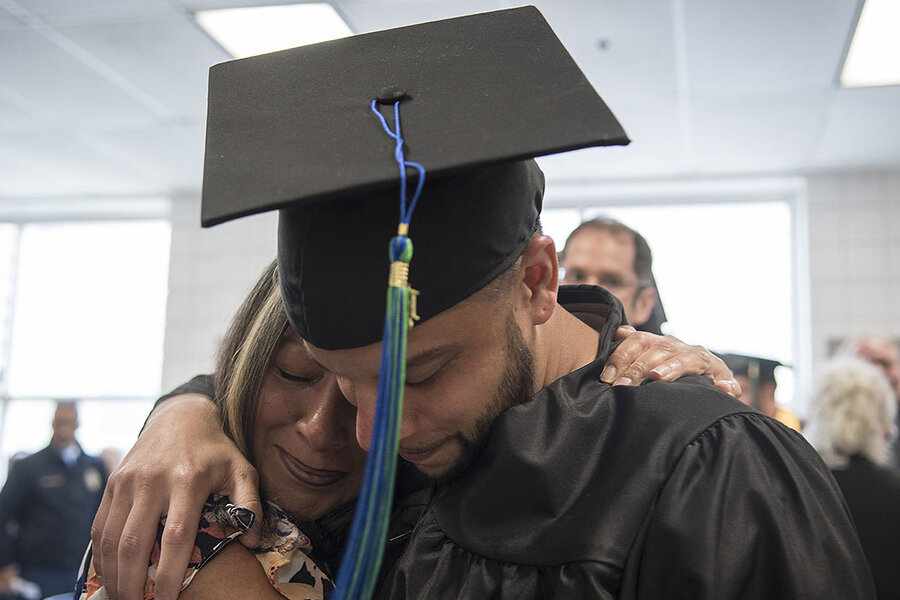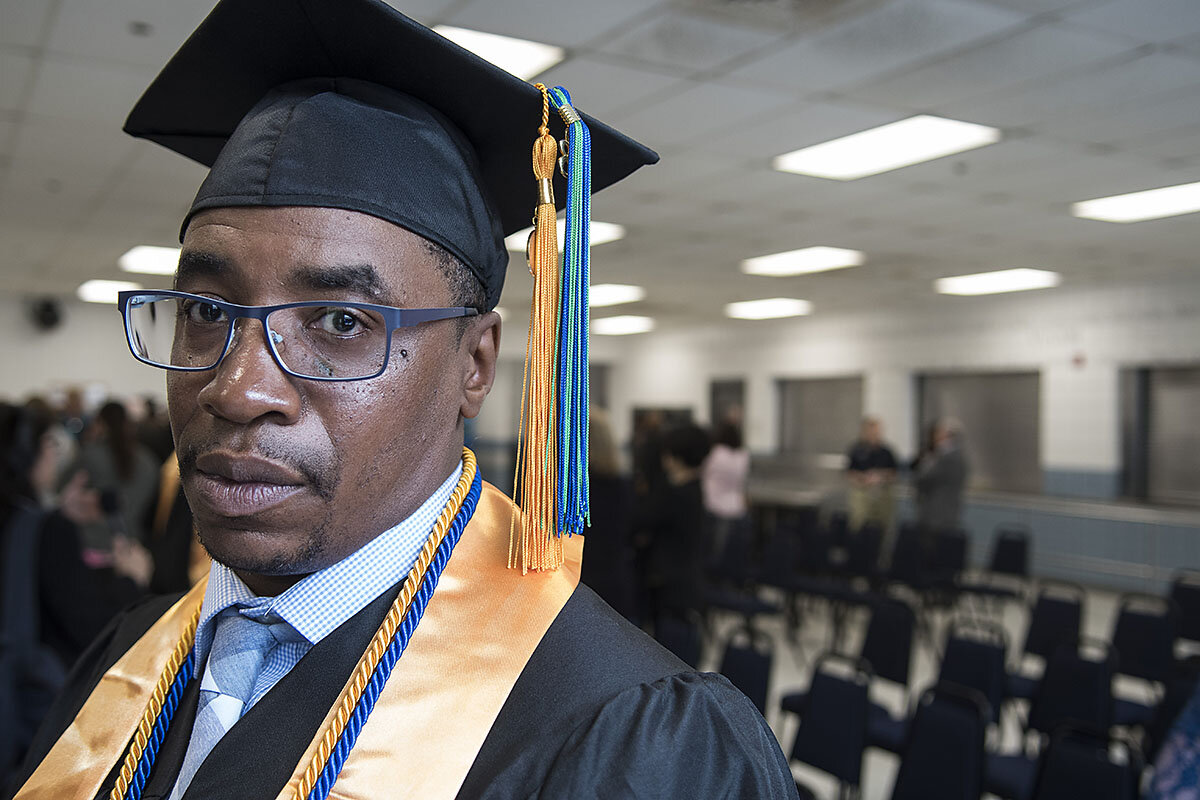Next up for prison reform: how best to use education as a path forward
Loading...
| Enfield, Conn.
To the organ sounds of Elgar’s “Pomp and Circumstance,” Robert Pratt sits upright in his royal-blue front-row chair. Behind the row of eight black-gowned men sit family members and other invitees; ahead, a line of be-suited officials flank a small dais.
For Mr. Pratt, this is his second graduation ceremony, his second try at balancing a mortarboard hat on his closely cropped head. A week earlier he had joined 500 other graduates from Asnuntuck Community College – the class of 2018 – inside a columnated concert hall. But this time feels different, more real. The guys on his row? They’re his classmates, his peers.
And the room where they sit in rows, waiting for their diplomas, is their prison chow hall.
Why We Wrote This
With high incarceration rates, the United States is focused on reducing recidivism. Providing access to education is one way to do so, offering a sense of engagement and value to those who are transitioning back into society.
Pratt is among nearly 5,000 incarcerated people who enrolled in college classes last fall as part of the Second Chance Pell program begun under President Barack Obama. It was the second year of an experimental program that funnels Pell Grants to those in prison in 27 states, a workaround for a population that for decades had been ineligible for federal financial aid.
Proponents say college classes for people in prison significantly increase their chances of finding steady work after release and lessen the risk of reoffending. A 2013 study found that incarcerated individuals enrolled in educational programs are 43 percent less likely to end up back in jail. As policymakers in Washington and state capitals grapple with the cost, injustice, and social ills of housing the world’s largest prison population, it’s an idea that is gaining ground.
“We see that across the political system there’s a general sense that if we provide more education, including post-secondary education, to people in prison, we will have better public safety outcomes. This is a common sense solution,” says Margaret diZerega, a project director at the Vera Institute of Justice in New York.
Legislative momentum stalled
Still, that common sense has yet to percolate into legislative action, so the program is funded using discretionary monies. A spokesperson for the Department of Education says it has no specific end date and will continue until the department has sufficient data “to make an informed decision on whether or not the experiment should be adopted into law or concluded.”
Similar experimental programs run for 3 to 5 years, says Ms. diZerega, whose organization was selected by the Department of Justice to provide technical assistance to participating colleges and prisons. “They can end at any time. We don’t know how long this one will go,” she says.
A flurry of efforts in Congress to strike bipartisan agreements on justice reforms have so far yielded one bill passed last month in the House of Representatives. The First Step Act focuses on early release and education and vocational training in federal prisons, tied to goals for reducing recidivism, but wouldn’t lift the ban on Pell Grant for prisoners. The Senate has yet to take up the bill.
Community colleges like Asnuntuck rely on Pell and other financial aid to enroll students, many from low-income families. Helping prisoners to fill out paperwork to file for financial aid was more challenging, says Eileen Peltier, dean of workforce development and continuing education. To be eligible for Second Chance Pell grants, students had to be less than five years from release and the programs had to be shown to make them more employable in local job markets.
For Pratt and his classmates, that meant studying for a certificate in advanced manufacturing; Connecticut has thousands of vacancies for welders, toolmakers, and machinists, according to state officials. Asnuntuck is also working in two other prisons and enrolled 317 inmates in the 2017-18 academic year in diploma programs, says Ms. Peltier.
Other colleges participating in Second Chance Pell offer associate and bachelor degree courses, though students often need to earn additional credits later to graduate.
Of the 60 or so incarcerated people enrolled at Quinebaug Valley Community College – using Pell Grants through the pilot program – around half go on to take more classes after their release, says Alfred Williams, dean of academic affairs and student services at the Danielson, Conn.-based school. “They want more. Their idea gets bigger,” he says.
Quinebaug has partnered with Brooklyn Correctional Facility, a medium-security prison in eastern Connecticut, to teach business and manufacturing classes five nights a week. He says the completion rate among inmates so far is around 90 percent, compared to 25 percent for typical students, and faculty have taken note. “The students [in prison] come to class more prepared that any on campus. They are motivated to learn.”
Like other officials involved in the program, Mr. Williams worries that its funding may not last. He’s looked at how Wesleyan University and others have developed privately funded prison programs and wonders if that could be an option. “One of the things we’ve talked about as a college is how we could fund this ourselves,” he says.
Civilian 'whiplash'
Willard-Cybulski Correctional Institution, where Pratt spent the last six years, is a low-security facility for prisoners who are nearing release. It has an unusual arrangement with its partnering college: Four days a week, vetted students are bused to Asnuntuck’s nearby campus where they trained on manufacturing equipment in a brand-new facility, while being kept separate from other students. They also take classes in the prison and study together on weekends.
Stefano Delgado says these campus days often induced whiplash. He would change into civilian clothes, taste the freedom of being on campus, being outside the barbed wire fence, then be bused back to his prison dorm by nightfall. But it was worth the struggle, he says, indicating his family who had come to the prison to see him receive his certificate.
“It’s a proud moment for me. Instead of a courtroom, it was a graduation,” he says.
The graduation on June 4 was attended by Gov. Dannel Malloy, who has pushed hard for criminal justice reform in Connecticut. A week earlier, he convened an all-day conference on the topic inside a maximum-security prison. When it’s his turn to address Cybulski’s class of 2018, he congratulates them for their perseverance and urges them to make a fresh start on the outside.
“You have what it takes to be successful. You possess the tools to turn your lives and the lives of others around,” he says.
He adds, “There’s nothing like a job to keep you straight.”
Pratt nods. He has a job interview the next day, his first crack of finding work. In January, he transferred to a halfway house, then last month he was released from custody. He now lives in Bridgeport with his wife, Jessica, who drove them both to Cybulski, his first time back.
“Today was special because I walked back into prison a free man. So it was surreal to see the guys that I left behind continue to strive to go forward,” he says.
The road to a diploma
Pratt was 16 when he was arrested for the murder of a pizza delivery man and his subsequent journey through the prison system maps onto the evolution of thinking in the United States on crime and punishment. The homicide took place in 1992, at the peak of a post-1960s violent crime wave that led policymakers to double down on harsh sentencing and zero-tolerance policing.
Pratt was convicted of homicide and sentenced in 1994 to 40 years in prison. That same year, Congress ended Pell Grants for prisoners, arguing that financial aid was only for law-abiding citizens. At the time, 23,000 federal and state prisoners at over 1,000 facilities were taking college courses, still a fraction of the four million recipients of Pell Grants.
The following year Pratt earned a GED certificate. But that seemed to mark the end of his prison education. Then in 2000, Connecticut began sending prisoners to Virginia to ease overcrowding and save money, and Pratt was among them. “While I was down there they had a lot of schooling in their system,” he says. He enrolled in an electrical class, but didn’t have time to complete it before he was transferred back to Connecticut in 2003.
Like many other states, Connecticut continued to build prisons and expand incarceration, even as the crime wave that roiled politics in the 1990s was rapidly receding. Between 1985 and 2008, the state's prison population tripled. Over the same period, national crime rates peaked before falling precipitously to 50-year lows.
After he moved to Cybulski in 2012, Pratt got another taste of prison learning. This time it was computer repair, and Pratt proved a keen student. So when he heard about the manufacturing program, he made sure that the warden, whose office supplies he delivered as his prison job, knew that he wanted in. “They saw what I was doing to improve my life,” he says.
By this stage, Pratt was in a reintegration center at Cybulski that Governor Malloy opened in 2015 as part of his justice reforms. The center has a separate wing for veterans; three of this year’s manufacturing graduates are former Navy and Army soldiers. It provides job training and other classes for prisoners nearing release, from anger management to addiction counseling.
After Pratt moved to the halfway house in January, he kept taking classes at Asnuntuck, a two-hour bus ride away. He would leave at 6am and return exhausted, both by the classwork and the disorientation of civilian life. “Everything was new. I was experiencing life all over again,” he says.
But he kept going back and graduated with honors. At the June graduation he wore the golden sash of Phi Theta Kappa. And when he rose to make his speech, he thanked college and prison officials for their support and later reached over to hug Malloy.
“I know where I came from. I’m no longer looking back,” he told the rapt audience. “The sky’s the limit. It’s a wonderful feeling.”











